CELL BIO: Chapter 11 - Membrane Structure
1/22
There's no tags or description
Looks like no tags are added yet.
Name | Mastery | Learn | Test | Matching | Spaced |
|---|
No study sessions yet.
23 Terms
General function of cell membrane (internal and external)
Prevent molecules on one side from freely mixing with those on the other side.
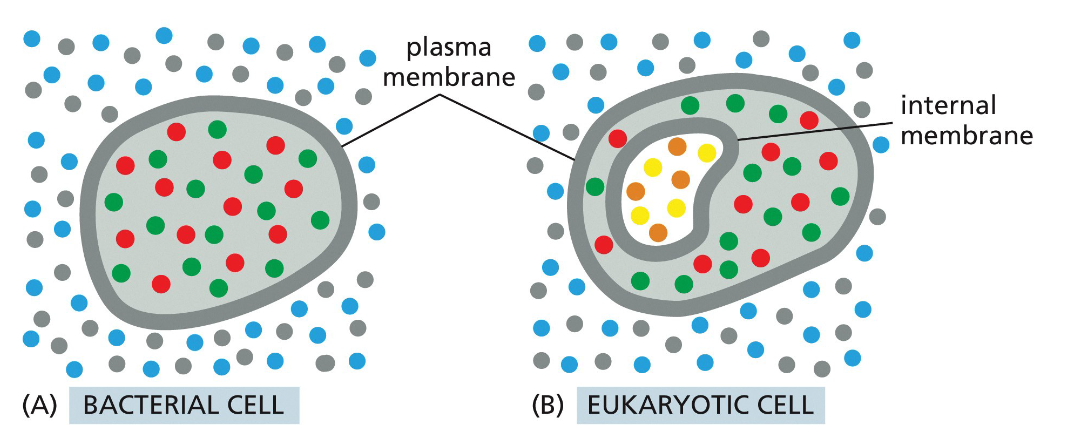
Receptor Proteins
Proteins in the cellular membrane that receive and transduce signals potentially used in cell functions.
How do receptor proteins read signals?
Signals to receptor proteins are typically chemical messengers which bind to a receptor and produce physiological responses (like change in the electrical activity of a cell)
Channels / Transporters
Import and export of small molecules and ions
Phospholipid bilayer
2 layers of phospholipids, each composed of 2 hydrophobic/nonpolar tails and hydrophilic/polar heads.
Amphipathic
Both hydrophobic and hydrophilic molecules
Types of lipid bilayer movement
lateral diffusion
flip flop
flexion
rotation
Function of momevment throughout lipid bilayer
Distributes different types phospholipids throughout bilayer
helps move phospholipids around newly made cells to protect them
helps proteins and phospholipids interact with each other
How do phospholipid tails become bent?
Double bonds in the hydrocarbons
How do bent hydrocarbon tails affect packing and subsequently function of the bilayer?
The bent hydrocarbon tails prevent close packing, effecting the fluidity of the membrane (temperature does as well).
Ideal conditions for membrane fluidity?
Goldilocks conditions, not too tight and not too loose. A phospholipid bilayer that’s packed too tight will freeze and break when temperatures drop, and one that’s too loose will let unwanted things into the cell.
How do you increase/decrease the fluidity of a membrane in animal vs prokaryotic/cells yeast ?
Prokaryotes & yeasts:
Change the length and amount of saturation of the tails
Animal:
Add cholesterol even throughout both monolayers which acts as a stiffener
Where / how are phospholipids made and intergraded into the membrane?
Made in the smooth endoplasmic reticulum.
New phospholipids are added to the side of the bilayer that is facing the cytosol. S
cramblases (transporter protein) randomly and with no ATP, will then move enzymes from one monolayer to another.
Goes from ER to Golgi
Filppases (in) then move certian phospholipids from noncytosolic monolayer and flip them to the cytosolic side
This curves the bilayer, making asymmetrical sides
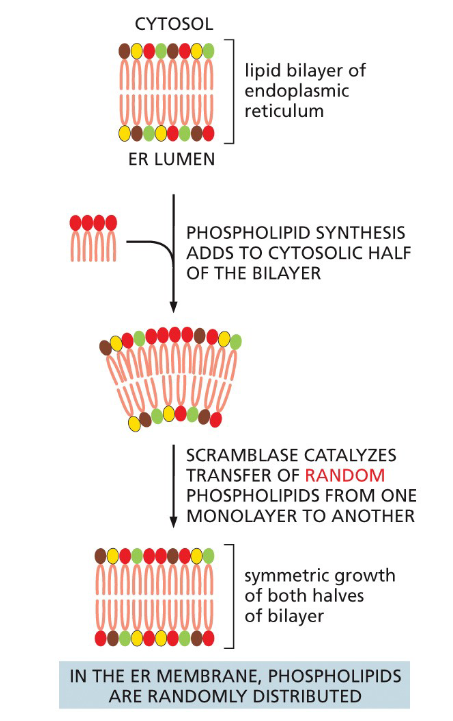
Why is asymmetry important in phospholipid bilayers?
Helps with the budding of membrane vesicles—bubbles of phospholipids that transport sugars and such from where they are made in the cell to outside it as the phospholipids then join the large layer.
Also important in cell signaling and activating enzymes.
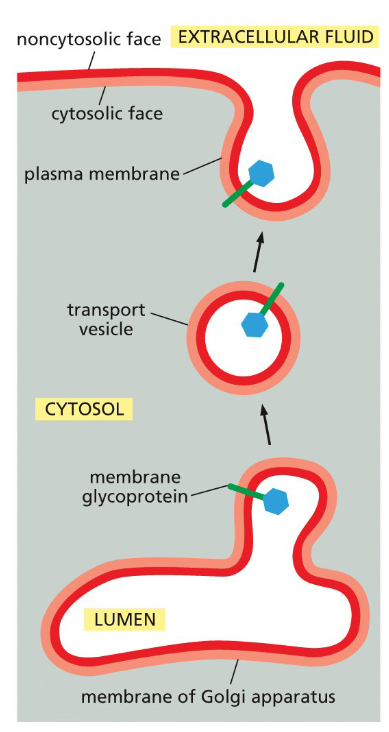
Types of plasma membrane proteins
transporters/channels
anchors
receptors
enzymes
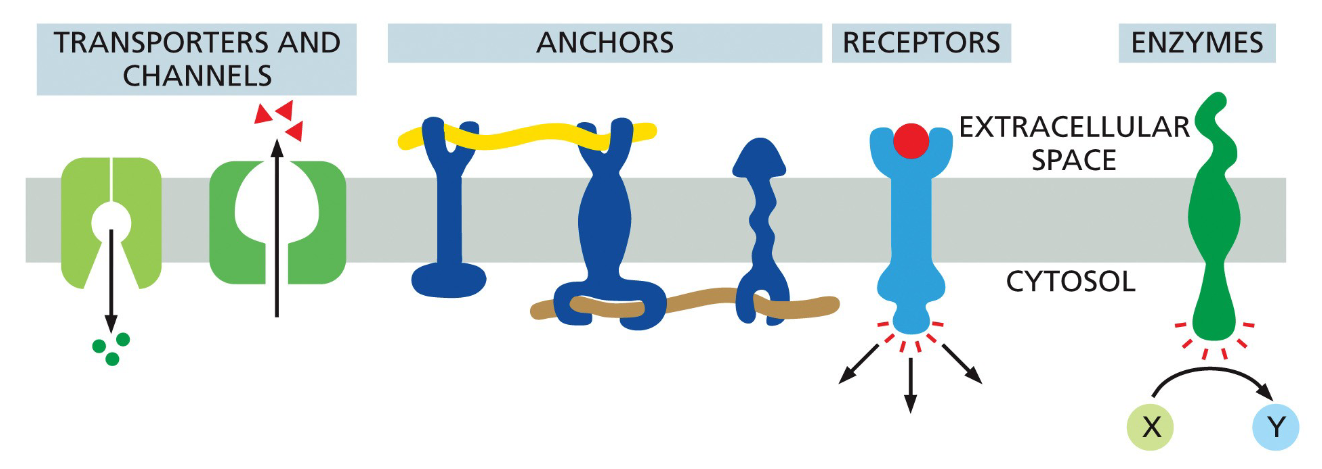
Typical structures of proteins that integrate/associate with lipid bilayer
A) Alpha helixes (transmembrane)
A) beta barrels/rolled up beta sheets (transmembrane)
B) amphipathic alpha helix (monolayer associated) (can form transmembrane hydrophilic pores!!)
C) covalently attached lipid molecule (lipid linked)
D) relatively weak noncovalent interactions with other membrane proteins (protein attached)

Effect of SDS detergent on phospholipid bilayer
The amphipathic detergent disrupts/breaks the lipid bilayer and interacts with the membrane-spanning hydrophobic portion of protein in the membrane. The phospholipids in the membrane are also solubilized by the detergents.

Bacteriorhodopsin
Acts as a protein pump, seven α helices guide the movement of the (H+) across the phospholipid bilayer
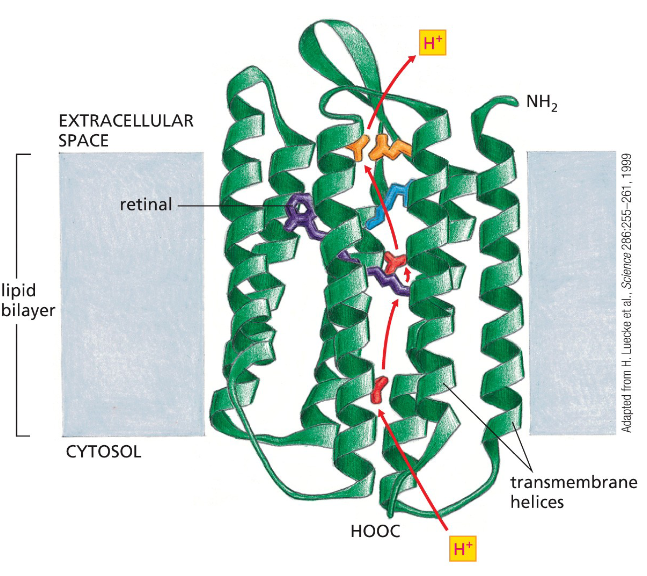
Spectrin
Spectrin is a cytoskeletal protein that lines the intracellular side of the plasma membrane in eukaryotic cells.
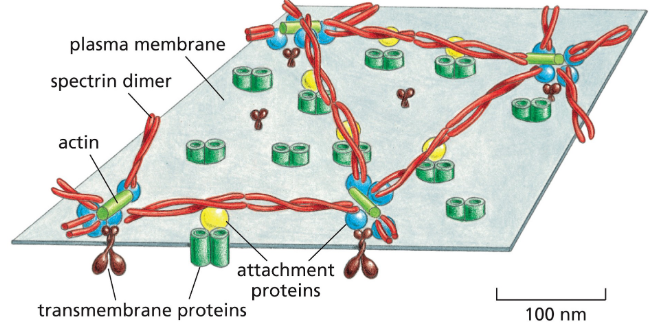
Actin
A family of globular multi-functional proteins that form microfilaments in the cytoskeleton
The lateral mobility of plasma membrane proteins can be restricted by tethering plasmid membrane proteins …
to the cell cortex inside the cell,
to extracellular matrix molecules outside the cell
to proteins on the surface of another cell
also,
Diffusion barriers can restrict proteins to a particular membrane domain
Tight junctions (specialized cell junctions)
Multiprotein junctional complexes between epithelial cells, sealing and preventing leakage of solutes and water
Glycocalyx
A layer of glycoproteins and glycolipids which surround the cell membranes of bacteria, epithelial cells, and other cells.
